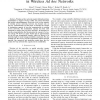139
Voted
TWC
2010
14 years 7 months ago
2010
The goal of this paper is to explore the benefits of channel diversity in wireless ad hoc networks. Our model is that of a Poisson point process of transmitters, each with a recei...
145
Voted
TIT
2010
14 years 7 months ago
2010
We directly lower bound the information capacity for channels with i.i.d. deletions and duplications. Our approach differs from previous work in that we focus on the information ca...
123
Voted
TCOM
2010
14 years 7 months ago
2010
Abstract--This paper surveys and unifies a number of recent contributions that have collectively developed a metric for decentralized wireless network analysis known as transmissio...
115
Voted
CORR
2010
Springer
14 years 10 months ago
2010
Springer
The transmission capacity of an ad-hoc network is the maximum density of active transmitters in an unit area, given an outage constraint at each receiver for a fixed rate of transm...
142
Voted
WIOPT
2010
IEEE
14 years 11 months ago
2010
IEEE
Abstract—Delay-reliability (D-R), and throughput-delayreliability (T-D-R) tradeoffs in an ad hoc network are derived for single hop and multi-hop transmission with automatic repe...
118
Voted
CORR
2010
Springer
14 years 11 months ago
2010
Springer
This paper develops upper bounds on the end-to-end transmission capacity of multi-hop wireless networks. Potential source-destination paths are dynamically selected from a pool of...
147
Voted
TWC
2008
15 years 29 days ago
2008
This paper derives the outage probability and transmission capacity of ad hoc wireless networks with nodes employing multiple antenna diversity techniques, for a general class of ...
101
Voted
CORR
2008
Springer
15 years 1 months ago
2008
Springer
Abstract--Interference between nodes directly limits the capacity of mobile ad hoc networks. This paper focuses on spatial interference cancelation with perfect channel state infor...
104
Voted
ICC
2009
IEEE
15 years 7 months ago
2009
IEEE
—Wireless ad hoc networks require bidirectional data transmission to support two-way traffic and control functions like packet acknowledgement. Most prior work on the capacity o...





